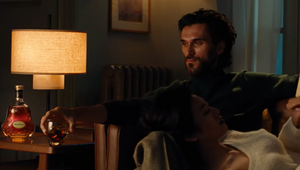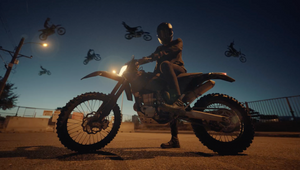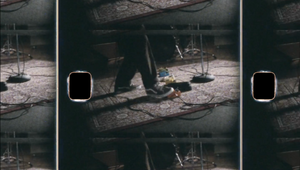
The Directors: Tino

Airton Carmignani, aka Tino, has made an indelible mark on the world of advertising with his innovative and highly aesthetic films. He began his career as an art director at F/Nazca Saatchi & Saatchi and became a full-time director with his partner Ricardo Jones, as the directing duo Jones+Tino, in 2011. Featuring strong narratives and intricate styling, Tino’s visionary films have earned worldwide recognition at D&AD, British Arrows, One Show, Clio, and Cannes Lions, including a Grand Prix in Film for co-directing Leica 100. He has directed ads for such clients as Nike, Orange, Tag Heuer, Axa, Netflix and Ancestry, among others.
Name: Tino
Location: US
Repped by/in: Loveboat (US & France)
Awards: One Show, D&Ad, Clio, British Arrows, LIA, Ciclope and Cannes Lions Film Grand Prix
LBB> What elements of a script sets one apart from the other and what sort of scripts get you excited to shoot them?
Tino> Advertising scripts come in all sizes, shapes and colours. One important element to set them apart is how open the scripts are to interpretation and inputs. It’s always more exciting when there’s room for collaboration.
LBB> How do you approach creating a treatment for a spot?
Tino> The first and most important part is to crack the idea and make it my own. I need to believe in it – or at least understand it – before starting. I feel like I need to find my way into the idea, or if you put it in a different way, I need to get a grip of the idea and from that moment on I’m able to tell that story.
The approach of creating the treatment itself varies and depends a lot on what comes out of the previous process.
Sometimes I start by breaking down the scenes, other times it is about finding a visual approach. Then, I write and write and in the end is an exercise of bringing it down and making it concise and straight to the point: what’s my vision, how it fits into the idea and how make it happen.
When I can’t find an angle, I feel the treatment becomes generic and boring.
LBB> If the script is for a brand that you're not familiar with/ don’t have a big affinity with or a market you're new to, how important is it for you to do research and understand that strategic and contextual side of the ad? If it’s important to you, how do you do it?
Tino> Usually, I get the strategic and contextual side of the project on the briefing call. After that my research is focused on the creative aspect of the project. Maybe there’s something about the way people use the product that will trigger some ideas for the film, then I will dig, but otherwise, I don’t overthink the business behind the ad.
LBB> For you, what is the most important working relationship for a director to have with another person in making an ad? And why?
Tino> The producer. I expect the producer to be the person to whom I can be totally open and transparent about what I’m thinking, what I know, what I don’t know, what I want to achieve. And more importantly, I expect that the producer will use all that knowledge to help me navigate production, politics, relationships and the creative result that I expect.
Like most of the relationships in filmmaking it takes time to develop trust and partnership but from time to time you work with someone that just clicks and it makes all the difference for the project.
LBB> What type of work are you most passionate about - is there a particular genre or subject matter or style you are most drawn to?
Tino> I don’t have a specific genre when it comes to advertising. I have a creative background and that was my way into filmmaking so I’m used to exploring different ideas and executions regardless of the genre.
I’m always looking for powerful imagery in my films. Something that pushes the story forward in a visual and memorable way. A lot of my favorite work combines reality and hyperreality, descriptive and sensorial.
Also I shot a lot of sports commercials and I discovered something really interesting about investigating different cultures through sports. There’s a human aspect to it that interests me. Working with non-actors, learning a new language, immersing in a different culture and finding empathy through sport.
When it comes to personal projects I’m more attracted to narrative works, more focused on drama and thrillers.
LBB> What’s the craziest problem you’ve come across in the course of a production – and how did you solve it?
Tino> There are a lot of crazy funny stories, but I’m not sure if it’s what you are looking for.
I’ve had weird stuff like hitchhiking in the desert after my car got stuck during a director scout in the desert in Chile. I ended up in Argentina where the border police helped me get a lift from a passing family who was driving back to the town where our production was based, San Pedro de Atacama.
There were art department trucks that never made it to an isolated location, so the art director had to build a gas station almost from scratch using whatever he could find in the small community where we were.
We also smuggled an Alexa in a backpack inside a basketball arena to shoot real game footage for a commercial.
Once there was this production driver - a diehard football fan - who literally took a crap in the middle of the corridor of the brand new arena of his rival team during a shoot. They caught him on the closed-circuit TV and he was arrested.
Oh, there was the time we were shooting a film on a speed boat when the boat began to take on water and started to sink…
That is the nature of production, unexpected problems in need of solutions.
LBB> How do you strike the balance between being open/collaborative with the agency and brand client while also protecting the idea?
Tino> I don’t put myself in that position: the protector of the idea. I bring a new perspective to the table with the treatment and that’s what I stand for.
It really helps when creatives, clients and directors are all working to do the same film. It’s not about agreeing creatively all the time, but it means that the idea is clear, and we all have the same goal. This allows creative discussions to happen within a specific conceptual frame.
I don’t take creative disagreements personally and I’m open to new ideas. I try to really listen with an open mind and that’s the most difficult part of the process: to be able to really listen instead of trying to speak. That’s how I expect people in the process to be as well. In a nutshell: be candid, respectful and let the best idea win.
LBB> What are your thoughts on opening up the production world to a more diverse pool of talent? Are you open to mentoring and apprenticeships on set?
Tino> The social-economic element is very important in my opinion. A lot of young professionals who do not come from privilege can’t afford to be interns or apprentices if that means not being paid. Also, simple meritocracy is not always the fairest selection tool if you want to be inclusive and bring underrepresented talents to the game. How can someone succeed within a system if they haven’t had access to it? We need affirmative actions in that regard. Not from the government or unions but from film companies and professionals. I see this not as social aid but as a business opportunity for both production companies and young professionals from underrepresented groups.
About mentoring and apprenticeships, the successful experiences that I have had were built on long-term, ongoing relationships. It’s not only about opening the set up to apprentices but also preparing them beforehand to be there. There’s so much for aspiring commercial directors to learn before even stepping onto a shoot. To be able to work on a project from its inception helps them to understand what standing on that set means. And more importantly the opportunity to get feedback and use what they learn on the next project will make them grow faster and become more focused as a professional. Technology during the pandemic gave us the chance to connect with professionals we admire more than ever - and we all should take advantage of that - but I still believe there’s something unique about the in-person apprenticeship relationship.
LBB> How do you feel the pandemic is going to influence the way you work into the longer term? Have you picked up new habits that you feel will stick around for a long time?
Tino> I was previously in NY shooting remotely in Kiev. The technology that makes that happen is not new and it was around way before the pandemic started. What changed was the mindset and the realization that things can be done in a different way. People are now more open to the fact that we don’t need to be all together in the same room to do great work together. Remote shooting won’t be the norm in the long term but will definitely open new possibilities to make a project happen. Instead of putting money on travelling, you can put it all in front of the camera and make a better film out of a smaller budget. And just like remote shooting there are other solutions that were originally designed for the pandemic reality that will be incorporated to the production workflow in the long term. If it’s good, why not keep it?
I wouldn’t say I picked up new habits, but I definitely had to use different skills to navigate the remote shooting process, for example. From how I assemble the crew, to how specific I have to be in pre-production. That led to more locations scouts to explore blocking with the cinematographer, longer callback sessions to make sure the actors would work, and super detailed documents so it was 100% clear to the team what I was thinking about. When it comes to shooting it’s a different kind of interaction you have with the actors and the crew. You need to trust people on the ground and let them do their job. You’re seeing and reacting in real time, but the response time is different from being on set, where everything is more organic. For a director it is hard because it is about giving up control a little bit in order to make it work.
From the human side I feel that everyone is putting more hours but producing less and making less money. People are on the edge emotionally. This past year was a great opportunity to slow down, take a step back and look to the humans behind the business. I hope the post-pandemic world consolidates a new era of soft skills in our industry.
LBB> Your work is now presented in so many different formats - to what extent do you keep each in mind while you're working (and, equally, to what degree is it possible to do so)?
Tino> Most commercial projects consider different formats just as an adaptation or cutdown of the hero film. When that’s the case I look at them through an objective and technical perspective: framing, titles sizes, compression setups. Other times there’s a whole second unit running in parallel on set, shooting extra content for social output but I don’t necessarily take part of it because there’s a different creative team leading it and I’m busy doing something else.
What interests me about different formats is the chance to incorporate them into the creative process from the beginning of the project. Like designing and shooting the scenes on 9:16 because you know that’s how you want the audience to experience that content or creating the whole narrative based on IG stories and posts embracing its language and limitations.
My career as a filmmaker was only possible because of a huge shift of formats in the late '00s. Digital DSLR cameras and online video platforms changed the way people produced and consumed video content and there was space for young filmmakers to experiment. From then on it never stopped and a filmmaker should always look at new formats as an opportunity to try something different.
LBB> What’s your relationship with new technology and, if at all, how do you incorporate future-facing tech into your work?
Tino> I’m not a pioneer of cutting-edge technology but I’m a curious and excitable person. Just like what we discussed before about pandemic and new formats I believe technology adds more tools to storyteller’s kit to help us craft our stories. I’m currently working on a commercial project that uses virtual sets and I’m super excited about it. The choice of using it was a creative decision and that’s how I feel comfortable about incorporating new technologies to my work. I’m also developing a personal project on VR storytelling and it’s a totally different thing.
LBB> Which pieces of work do you feel really show off what you do best – and why?
Tino> I just moved into directing solo after years of co-directing and this is an exciting time for me to discover my own voice as a filmmaker. I picked some recent work that I believe are personally important and are helping me to do that.
The Orange Footballs film has a crafted documentary approach to a specific subject – football in this case - that allows me to dig into a local culture, research a lot and work with non-actors, which I really like. Publicis Conseil and Orange were brave and trusting to allow me to work without storyboards and to explore and react to what the research brought up to us during pre-production, always keeping it truthful to the creative concept.
AXA Speak Up has a hyper-real and symbolic visual approach to storytelling that I really love doing. It was a great collaborative process with Fallon London during treatment and pre-production when we were trying to crack who the characters of our story – all based in real life stories - would be. Although it is not a classic narrative film there was a lot of work with the actors to find the right tone for each part of the film.
TAG Heuer Time allowed me to experiment a different approach to sports film that I was used to. It’s dynamic and intense without losing the brand’s sophistication. DDB Paris and TAG Heuer were open to different ways to interpret the concept and that allowed me to combine in-camera techniques, lighting and post-production to achieve the feeling we’re looking for.
Ballerina Soldier - It's very simple yet very meaningful to me. Using dance as the main narrative element was something I had never done before. We experimented a lot with still cameras, light and even A.I. interpolation software to try and find the best way to reproduce the flash photography look we were aiming for. It was my first 100% remote production and I learned a lot.













